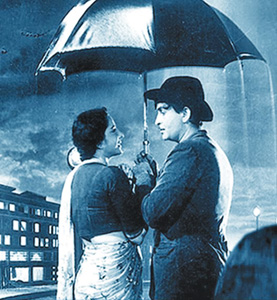Of all the seasons, the monsoon is the best, in spite of the flooded roads, railway tracks, traffic jams and telephone lines being ‘katti’ with you. It’s the most audible of all seasons with an entire gamut of ‘dhoom-dhadakas’ of thunder, savage winds lashing out at trees and making them sway like the ‘sega’ dancers of Mauritius and the streaks of lightning.
The monsoon has inspired writers, poets and musicians. Rabindranath Tagore’s songs on Varsha-Ritu are an integral part of Rabindra Sangeet. The ‘megh raag’, with its ‘umad-ghumad’ words, was born out of Lord Shiva, according to Hindu mythology. Rain itself is like fusion music: the fearful howling of the wind, the pitter-patter of raindrops on windows, the thuds on tin-roofs, the cascading sheets of water merging with the waves of the sea, just as the atma merges into the parmatma on death.
Kalidas has pointed a royal image of the rains in his ‘Ritusamhaar’, talking of princely thunderbolts that strike terror, bows and arrows strung with lightning streaks, an army of showers, stubborn trees, fearful clouds and rain descending like a king’s army, to infuse new life into parched Mother Earth. The musical genres of Sawan, Kajri and Jhula songs are inspired from these.
Tansen, one of the Navratnas in Emperor Akbar’s court, created a genre of Indian classical monsoon music called Miyan-ki-Malhaar. The blind poet Surdas created Sur-Malhaar. Likewise, the Ramdasi Malhar is credited to musician Ramdas. The saint-poet of Gujarat, Mirabai sang in Mira-ki-Malhaar while Rani Roopmati sang in Roop-Malhar.
There are so many off-shoots of Raag Malhar like Bhairvi, Naath, Soranth, Chaya-Gaudgiri and Raag Tukari. In fact, the Sikh’s holy book, Guru Granth Sahib, even has a couple of songs in reference to the rainy season composed by Guru Nanak, depicting various moods of the rains in Rag Tukari. Other musicians and poets like Subandri and Vidyapati have also composed divine pieces inspired by the monsoo n. There are almost two dozen varieties of Raag Malhar.
n. There are almost two dozen varieties of Raag Malhar.
In old Hindi films, the commonest theme in monsoon songs was the longing of lovers for each other like ‘Sawan ke Badalon’, ‘Unsey Ye Ja Kaho’ from ‘Ratan’ or ‘Jhuk Kar Ayi Re Badariya’ from film ‘Bhabhi’. Passion was totally understated by lovers in songs like ‘Zindagi Bhar Nahi Bhulegi Voh Barsat Ki Raat’ (Madhubala and Bharat Bhusan) or ‘Rim Jhim Ke Tarane Lekey Ayi Barsat’ (Waheeda Rehman and Dev Anand) or ‘Kali Ghata Chhye, Mora Jiya Ghabaraye (Nutan) or ‘Pyar Hua Ikrar Hua’ (Nergis and Raj Kapoor). There was innocence in songs like ‘Lapak Jhapak Tu Aa Re Badarya’ (David) or the theme song of ‘Toofan Aur Diya’ viz. ‘Nirmal Se Ladai Balwaan Ki’ or again ‘Ek Ladki Bheegi Bhaagi Si’ (Madhubala and Kishore) in ‘Chalti ka Naam Gaadi’.
The songs that followed started becoming vulgar like the ‘Khatia-Ghatia’ and ‘Choli-Ghagra’ songs and the rain in Hindi flicks invariably led to the heroine’s unplanned pregnancy. Dances in the rain started looking more like foreplay with the heroine in a transparent white sari. The lovers zoomed off to the nearest cave or guest house for a quickie (remember Sharmila-Rajesh’s ‘Roop Tera Mastana’)? The morning after, everything was regretted with ‘hamey aisa nahin karna tha’ but junior was already conceived since it was always the lady’s (fertile) unsafe day when such accidents occurred!
In Bollywood, rains always arrive on time with huge studio-fans and rain-machines but ignorant film makers make it pour off-season too e.g. In ‘Kasoor’, it rained the year round. In ‘Dil Hi Dil Mein’, it rained on Valentine’s day (14th February) and in ‘Dayavaan’, it poured on Holi.
It’s always on a stormy night that the heroine is thrown out of her house by the husband or mother outlaw (oops! in-law) though she is a ‘ganga jal ki tarah’ pure woman. It’s the naughty girls who have all the fun in the rain like Mumtaz in ‘Do Raste’ or Zeenat Aman singing ‘Teri Do Takiye Ki Naukri’ in ‘Roti Kapda Aur Makan’. Smita Patil dancing with Amitabh Bachan in Namak Halal’s ‘Aaj Rapat Jaye’ was sensuous without being vulgar.
Raveena Tandon’s gyrations in ‘Tip Tip Barsa Pani’ were gross, while Urmila Matondkar’s dance in Satya, ‘Pani, Geela Pani’ was completely deleted by the Censor Board. One pines for Jaya Bahuduri’s ‘Bole Re Papihara’, Manisha’s ‘Rim Jim, Rim Jhim’ or Sadhana’s ‘O Sajana, Barakha Bahaar Ayi’. Nostalgia in this season makes the heart grow fonder as one listens to ‘Aya Sawan Jhoom Ke’ and visualizes a young and handsome Dharmendra in his heydays, dancing in the rain!
- The Real Beauty Secret - 13 April2024
- Frenymai And The Fake Godman – II - 30 March2024
- Meherbai’s Mandli Discusses Coomi Kaajwali’s Match-Making Secrets! - 16 March2024
